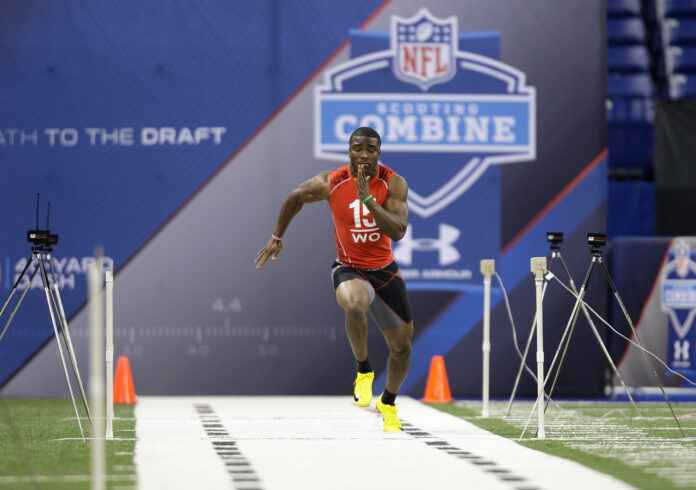NFL Combine’s Top Test Fuels Perception, Dollars for Players
At the NFL Scouting Combine, various activities unfold: interviews, medical examinations, media interactions, and on-field drills.
Yet, amid this multitude, the 40-yard dash conspicuously commands the lion’s share of public attention.
As the Combine’s notoriety has surged over recent years, numerous narratives have sought to decipher the intricacies of evaluating a player based solely on their 40-yard dash time.
The 40-yard dash is a fundamental metric that scouts covet, although its true significance often diverges considerably from its glamorous spotlight.
Nevertheless, its significance should not be understated.
A common counterargument often arises: How frequently do players dash 40 yards consecutively in an actual game, akin to the Combine’s examination? The answer, in reality, is seldom, if at all.
Offensive linemen, for instance, rarely embark on runs exceeding 40 yards unless they’re celebrating a touchdown in the end zone. This holds true for defensive linemen as well.
When it comes to wide receivers and the defensive backs shadowing them, their routes might occasionally extend beyond the 40-yard mark. Still, it’s essential to note that these routes are rarely perfectly straight, and there’s typically an initial contact point that diverges from the Combine’s idealized test scenario.
When you have to justify the selection of one player over another to an owner or executive, the simplest justification is to look at the quantifiable.
It’s not exactly a groundbreaking revelation, given that by now, it’s widely accepted that a player’s ability to sprint 40 consecutive yards is far from the defining trait of a great football player.
In fact, it’s challenging to encounter anyone in the football world who genuinely believes that it holds such a paramount position.
Nevertheless, the 40-yard dash time persists as the central element of intrigue and the foremost label a player carries with them throughout their football career once they depart the Combine.
This paradoxical relationship is, to say the least, perplexing.
Despite countless voices, both from within and outside the football fraternity, highlighting the limited relevance of this test, players remain acutely aware that their 40-yard dash time can significantly bolster or diminish their stock.
A swift performance at the Combine can translate into a windfall, potentially generating hundreds of thousands to millions of dollars on a rookie contract. Conversely, a lackluster showing may cost a player an equivalent amount.
However, it’s crucial to remember that almost everyone involved comprehends the test’s limitations concerning its direct applicability to football.
As a player, navigating this apparent contradiction becomes a central challenge.
You invest substantial effort in training for a drill that possesses limited correlation with the game itself but undeniably shapes perceptions regarding your draft status. This encapsulates the essence of the NFL scouting process.
In the video, you can witness Terron Armstead’s remarkable 40-yard dash performance from 2013, where he blazed through the distance in an unprecedented 4.65 seconds.
This time, he etched his name in the annals of NFL Combine history as the fastest ever recorded for an offensive lineman.
Hailing from a modest institution like Arkansas-Pine Bluff, this extraordinary display of speed played an instrumental role in catapulting Armstead into the NFL, as he was selected in the third round by the New Orleans Saints.
When it comes to evaluating an offensive lineman’s ability to block opponents effectively, the 40-yard dash appears far from the most pertinent criterion.
However, Armstead’s exceptional feat on that day underscored his innate athleticism, and in retrospect, it rationalizes the decision to take a chance on a player emerging from a smaller school.
In this context, Armstead’s 40-yard dash time served as a remarkable springboard to kickstart his professional career, despite the apparent incongruity between this test and the core responsibilities of his role in the NFL.
During my attendance at the Combine, I found myself among those who greatly reaped the benefits of posting a swift 40-yard dash time.
In the lead-up to the 2005 NFL Draft, my speed emerged as the most pressing question mark about my abilities. Many NFL decision-makers, coaches, and scouts grappled with the challenge of gauging my speed solely from college game footage.
Consequently, my speed became a recurring topic of discussion during my interviews at the Combine.
One memorable exchange unfolded with none other than Tony Dungy, who, with keen interest, inquired about my 40-yard dash time.
He posed the question, “Do you believe you can complete the 40 yards in under 4.7 seconds?”
My response was resolute: “Yes, I can.” To this, Dungy astutely remarked, “Running under 4.7 seconds would significantly enhance your draft stock.”
I also had a pivotal interaction with Winston Moss, who, coincidentally, would later become my outside linebackers coach at Green Bay.
Moss left no room for ambiguity when discussing my speed, asserting that if I couldn’t clock in faster than a 4.8-second 40, the NFL might not be the right fit for me.
According to him, NFL linebackers, at the very least, should be registering 4.7 or better.
When my moment arrived, I seized the opportunity to astound numerous scouts, executives, and coaches by dashing the 40 yards in a blistering 4.59 seconds, all while weighing 259 pounds.
This eye-popping performance propelled my stock from a projected sixth- or seventh-round prospect to a potential third-rounder or even as low as a fifth.
Notably, the difference in signing bonuses between the fourth round, where I was ultimately drafted, and the seventh round in 2005 amounted to a staggering $350,000-plus.
It’s abundantly clear that my 40-yard dash time played a pivotal role in augmenting my rookie contract by approximately $350,000.

What makes the 40-yard dash such a pivotal evaluation metric? The answer lies in its inherent quantifiability.
Within the nerve centers of most draft decision-making rooms, there’s a meticulously organized list of prospective players, each categorized according to their respective positions.
I can personally attest that in the Green Bay Packers war room, the names of players are prominently accompanied by their corresponding 40-yard dash times.
The 40-yard dash evolves into a rapid and convenient shorthand for assessing a multitude of prospects.
When the time comes to justify the selection of one player over another to team owners or executives, the simplest and most straightforward route is to turn to quantifiable data.
A player boasting a 4.5-second 40-yard dash time often proves an easier “sell” than a counterpart with a 4.8-second time, even if the rationale behind this preference may seem somewhat superficial.
In the realm of NFL scouting, a quantifiable statistic serves more effectively than attempting to expound upon the immeasurable qualities, such as heart, even though the latter holds immeasurable significance.
It is an acknowledged fact that running the fastest 40-yard dashes does not inherently guarantee a player’s ascent to greatness in the NFL from a given year’s draft class.
Nevertheless, the 40-yard dash serves as a valuable form of currency at the NFL Scouting Combine, capable of either enhancing or detracting from a prospect’s prospects.
Despite the inherent limitations of the 40-yard dash in predicting future success, there’s an undeniable undercurrent of tension and excitement that pervades the event.
Ultimately, the player must set aside any reservations, dedicate themselves to rigorous training, and adeptly navigate the series of tests.
Whether one finds themselves in agreement or disagreement with the significance of the 40-yard dash, the fact remains that substantial financial stakes are at play.

